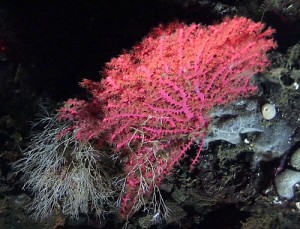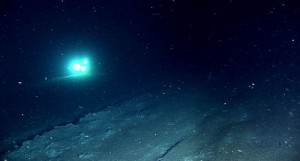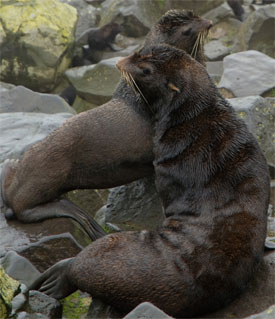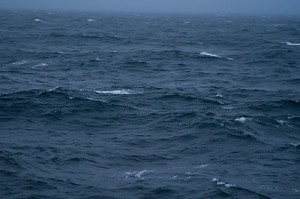
A bald eagle sits atop Unalaska’s Russian Orthodox Church of the Holy Ascension with Esperanza at anchor in background.
(Photo by David E. Guggenheim)
With a Terabyte (1,000 Gigabytes) of high-definition video, photographs and other data, along with numerous biological samples, now making their way around the world to scientists, policymakers and public forums, new insights and perspectives are emerging as the hard work of reviewing this vast volume of new data moves forward. The science team and sub pilots have departed Esperanza, which is continuing west along the Aleutian Island chain, continuing important outreach to local communities. The ship will eventually continue west to Japan.
Before departing Dutch Harbor, the science team/sub pilots made the first public presentation of its findings, including imagery and videos, to the community of Unalaska. The following day, members of the community were invited aboard Esperanza during an Open House to meet with the crew and see the ship up close.

Greenpeace Ocean Specialist, John Hocevar (left) and Greenpeace Oceans Campaigner, George Pletnikov (right) lead community outreach event in Unalaska, Alaska. (Photo by David E. Guggenheim)
Though the at-sea portion of the expedition has concluded, much work lies ahead in the analysis and review of the information collected. In addition, planning is underway for events to bring the new imagery and insights to the public, so stay tuned. Also, the team continues to review chart data regarding the pinnacles reported to be in the Zhemchug Canyon area which purportedly rise within 20 feet of the surface. Such features would certainly be biologically important, so the search will continue.
Pribilof and Zhemchug Canyons revealed diverse and complex ecosystems, rich with corals, sponges, fish and other marine life. They also revealed striking human impacts from trawlers, damage that was documented during the expedition. For a reflection on the conclusion of the expedition, read David Guggenheim’s latest OceanDoctor blog post entitled, “A Sea Turtle is Born in Alaska.”
The Esperanza carried two manned submersibles, a remotely-operated vehicle (ROV) and an international research team to the Bering Sea for a three week survey of Zhemchug and Pribilof Canyons,to map and document deepwater corals living at depths of more than 1,000 feet. The expedition was conceived of and was led by Greenpeace. Read more


 I awakened at 4am in my bunk to something strange. The ship was still. After enduring two days of pounding seas and gale-force winds, we had at last arrived at the island of Unalaska and were nearing the port of Dutch Harbor. A few hours later, juggling my cameras, I tried in vain to capturethe profound tranquility of that early Alaskan morning as dawn’s gentle glow painted small swaths of green across the surrounding mountains atop a canvas of deep blues and grays.An incredible journey was nearing its end, and I was reluctant to let go. So was the wildlife. In a moment, the morning silence was replaced by shrieks from the deck below. They were shrieks of joy as once again we were surrounded by whales as a pod of humpbacks divided itself evenly and passed closely along both sides of us, filling the morning air with their spouts and flukes.
I awakened at 4am in my bunk to something strange. The ship was still. After enduring two days of pounding seas and gale-force winds, we had at last arrived at the island of Unalaska and were nearing the port of Dutch Harbor. A few hours later, juggling my cameras, I tried in vain to capturethe profound tranquility of that early Alaskan morning as dawn’s gentle glow painted small swaths of green across the surrounding mountains atop a canvas of deep blues and grays.An incredible journey was nearing its end, and I was reluctant to let go. So was the wildlife. In a moment, the morning silence was replaced by shrieks from the deck below. They were shrieks of joy as once again we were surrounded by whales as a pod of humpbacks divided itself evenly and passed closely along both sides of us, filling the morning air with their spouts and flukes. 






